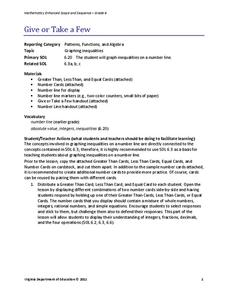EngageNY
From Rates to Ratios
Look at rates from a general perspective. The 17th part of a 29-part series provides problems that help pupils develop more general ratios from given rates. Scholars determine unit rates and ratios that are associated with given rates....
Virginia Department of Education
Give or Take a Few
Young mathematicians extend their knowledge of rational numbers on a number line to graph inequalities by first using number cards to compare rational numbers. They finish by using similar reasoning to graph inequalities on a number line.
EngageNY
More Examples of Functions
Discrete or not discrete? Individuals learn about the difference between discrete and non-discrete functions in the fourth installment of a 12-part module. They classify some examples of functions as being either discrete or non-discrete.
Charleston School District
Constructing Dilations
Pupils multiply the vertical and horizontal distances from the center of dilation by the scale factor. The independent practice prompts the class to analyze the relationship between the image and pre-image. The lesson is...
EngageNY
Factoring Expressions
Factor in an informative resource when teaching about factoring. The 11th lesson in a 36-part module shows pupils how to factor algebraic expressions by applying the distributive property. Some of the problems involve expressions with...
EngageNY
Solving Area Problems Using Scale Drawings
Calculate the areas of scale drawings until a more efficient method emerges. Pupils find the relationship between the scale factor of a scale drawing and the scale of the areas. They determine the scale of the areas is the square of the...
Virginia Department of Education
Logic and Conditional Statements
If there is a conditional statement, then there is a hypothesis and conclusion. Pupils learn how to identify the parts of conditional statements. Class members continue to work with conditional statements and rewrite them in their many...
Curated OER
The Part-adder 1
Second graders investigate the addition of whole numbers. They mentally perform calculations involving addition and subtraction. They make sensible estimates and check the reasonableness of answers.
Curated OER
Equal Parts
In this fraction worksheet, 2nd graders analyze basic fractions. Students complete 8 questions, coloring only those that show equal parts.
Curated OER
Independent Practice 2: Modeling Fractions
In this modeling fraction worksheet, students color parts of boxed areas to represent a given fraction. They create models of fractional parts. This one-page worksheet contains 21 problems.
Curated OER
Fraction Models
In this elementary math worksheet, 6th graders examine the shaded areas of fraction models in order to determine if the given number sentences are true for the three questions.
Curated OER
Fraction Circles
For this math worksheet, students examine 6 circles, each divided to show different fractions: halves, thirds, fourths, sixths and eighths. There are no directions on the page but students could color or label the fractions.
Curated OER
Fractions
First graders create fraction creatures by using 1 inch squares of construction paper. In this fractions lesson plan, 1st graders name the fractions within their whole creatures.
Curated OER
Represent Fractions
In this fractions worksheet, students solve 22 problems in which a fraction is written to describe the shaded parts of a whole. Students also draw pictures to illustrate fractions.
Illustrative Mathematics
Make 9
Learning how numbers are put together as parts and wholes is a big step in building the foundational number sense of young mathematicians. Here, children are given a number less than 10 and are asked to find as many pairs of numbers as...
Curated OER
Half- Thirds- Quarters
A one page worksheet for early fraction learners. They check 3 diagrams in which a shape is analyzed and the indicated part is marked as: one half, one third, or one quarter.
Curated OER
Let's Share Equal Parts
Students practice creating parts of a whole by using educational software to illustrate their learning.
Curated OER
Who Has More?
Students engage in a lesson plan that is concerned with the standard of comparing the quantities of whole numbers using different strategies from the concrete to the abstract. They count objects and compare them, use symbols of...
Curated OER
Pizza Fractions
Students are introduced to fractions by completing 2 pages of problems with a pizza theme. They complete a chart where they name the fractional part they see in pizzas, then shade the pizzas to solve 1o word problems.
Mary Pope Osborne, Classroom Adventures Program
Mummies in the Morning Egyptian pyramids, hieroglyphics
Visit the Magic Treehouse and take your class on a trip through time with a reading of the children's book Mummies in the Morning. Using the story to spark an investigation into Egyptian culture, this literature unit engages...
Curated OER
Hand Span and Height
Is there a relationship between hand span width and height? Statisticians survey each other by taking measurements of both. A table that can hold data for 24 individuals is printed onto the worksheet, along with questions for analysis....
Mathematics Vision Project
Module 1: Getting Ready Module
This fabulous resource is a must-have for any algebra teacher's arsenal of lessons. Developing the idea of equations and use of variables from basic physical scenarios, learners gain valuable intuition in the structure and meaning of...
Curated OER
Study Buddies - Proportions
Middle-schoolers solve various problems related to proportions. They write ratios in word form and then, replace the words with numbers. Pupils also write an equation in which they will cross-multiply to solve the proportion. This is an...
Teach Engineering
Messin' with Mixtures
Do you separate your trail mix before eating it? Then you've been separating mixtures your whole life! Scholars model a contaminated soil sample using trail mix and estimate the percentage of each component. They consider how to clean up...























